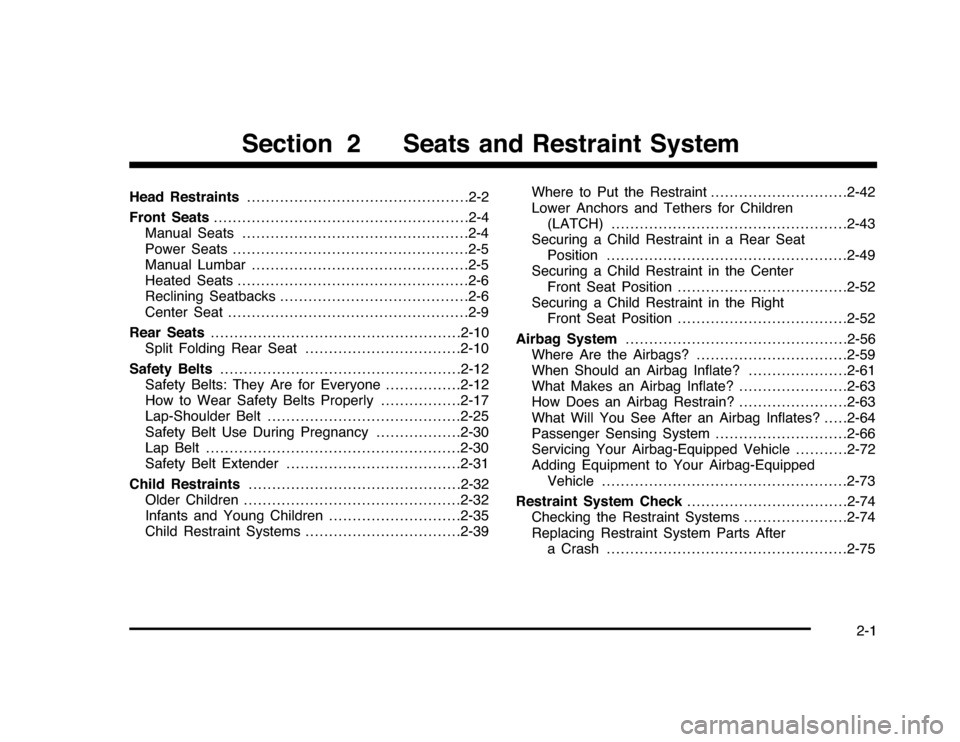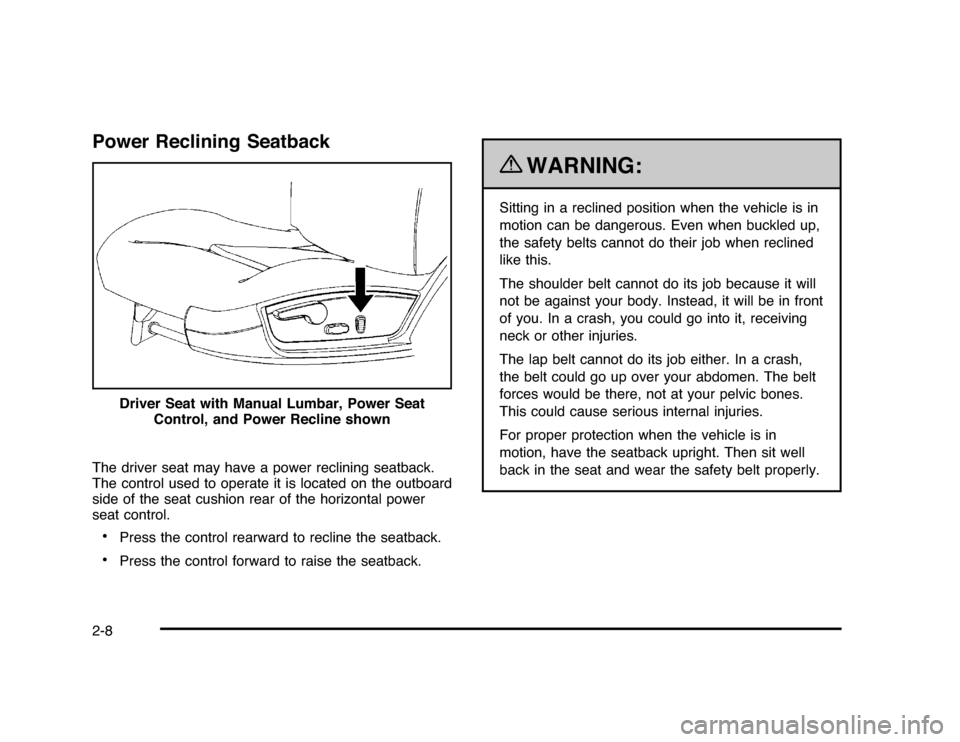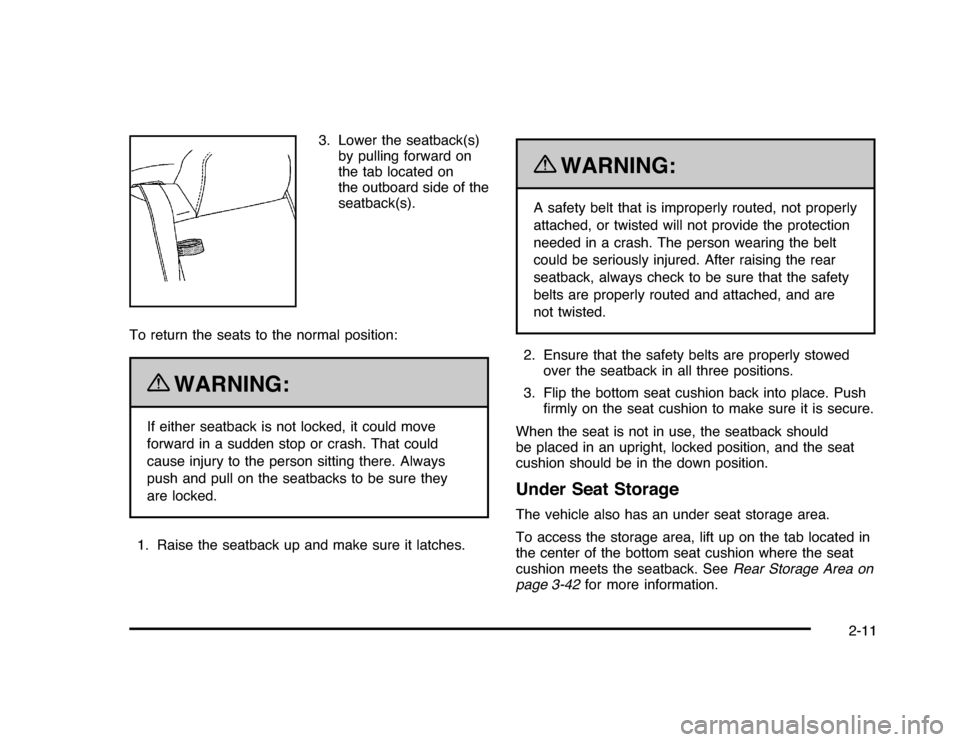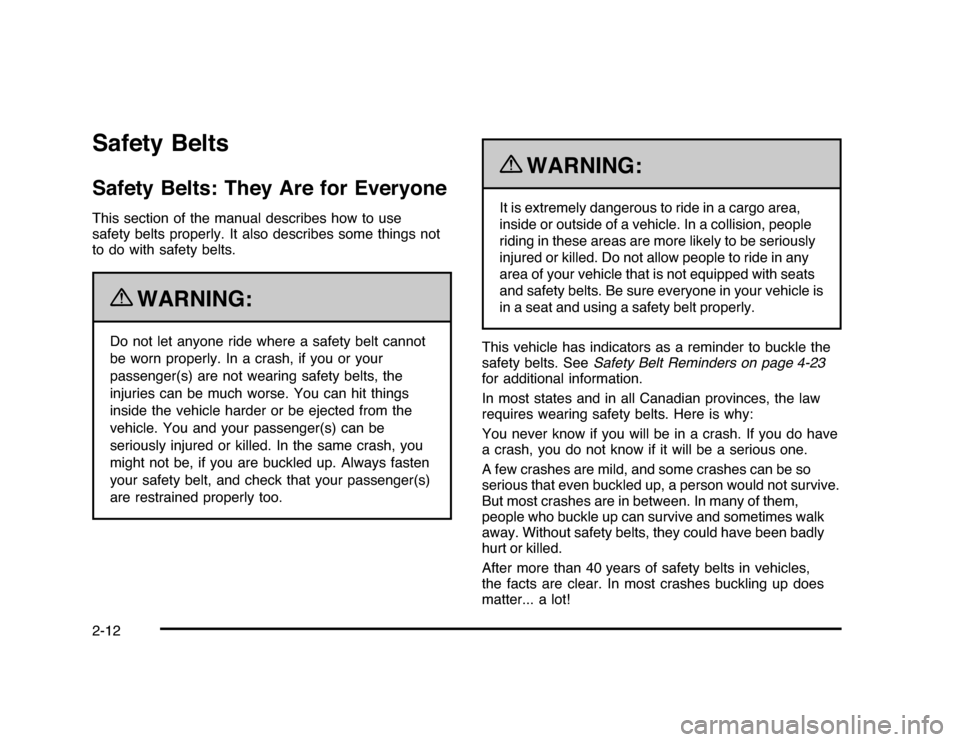2010 CHEVROLET IMPALA belt
[x] Cancel search: beltPage 1 of 432

In Brief........................................................... 1-1
Instrument Panel
........................................ 1-2
Initial Drive Information
............................... 1-4
Vehicle Features
......................................1-15
Performance and Maintenance
...................1-19
Seats and Restraint System............................. 2-1
Head Restraints
......................................... 2-2
Front Seats
............................................... 2-4
Rear Seats
..............................................2-10
Safety Belts
.............................................2-12
Child Restraints
.......................................2-32
Airbag System
.........................................2-56
Restraint System Check
............................2-74
Features and Controls..................................... 3-1
Keys
........................................................ 3-3
Doors and Locks
....................................... 3-9
Windows
.................................................3-14
Theft-Deterrent Systems
............................3-16
Starting and Operating Your Vehicle
...........3-19
Mirrors
....................................................3-33Universal Home Remote System
................3-35
Storage Areas
.........................................3-42
Sunroof
..................................................3-43
Instrument Panel............................................. 4-1
Instrument Panel Overview
.......................... 4-3
Climate Controls
......................................4-16
Warning Lights, Gages, and Indicators
. . . . . . . . 4-21
Driver Information Center (DIC)
..................4-37
Audio System(s)
.......................................4-57
Driving Your Vehicle....................................... 5-1
Your Driving, the Road, and the Vehicle
....... 5-2
Towing
...................................................5-26
Service and Appearance Care.......................... 6-1
Service
..................................................... 6-3
Fuel
......................................................... 6-5
Checking Things Under the Hood
...............6-12
Headlamp Aiming
.....................................6-43
Bulb Replacement
....................................6-43
Windshield Wiper Blade Replacement
. . . . . . . . . 6-49
2010 Chevrolet Impala Owner Manual
M
Page 5 of 432

Vehicle Symbol ChartHere are some additional symbols that may be found on
the vehicle and what they mean. For more information
on the symbol, refer to the index.9
:Airbag Readiness Light
#
:Air Conditioning
!
:Antilock Brake System (ABS)
g
:Audio Steering Wheel Controls or OnStar
®
$
:Brake System Warning Light
"
:Charging System
I
:Cruise Control
B
:Engine Coolant Temperature
O
:Exterior Lamps
#
:Fog Lamps
.
:Fuel Gage
+
:Fuses
i
:Headlamp High/Low-Beam Changer
j
:LATCH System Child Restraints
*
:Malfunction Indicator Lamp
:
:Oil Pressure
}
:Power
/
:Remote Vehicle Start
>
:Safety Belt Reminders
7
:Tire Pressure Monitor
F
:Traction Control
M
:Windshield Washer Fluid
v
Page 7 of 432

Instrument Panel..............................................1-2
Initial Drive Information....................................1-4
Remote Keyless Entry (RKE) System................1-4
Remote Vehicle Start......................................1-4
Door Locks....................................................1-5
Trunk Release...............................................1-5
Windows.......................................................1-6
Seat Adjustment.............................................1-6
Second Row Seats.........................................1-8
Head Restraint Adjustment...............................1-8
Safety Belt....................................................1-9
Sensing System for Passenger Airbag...............1-9
Mirror Adjustment.........................................1-10
Steering Wheel Adjustment............................1-11
Interior Lighting............................................1-11
Exterior Lighting...........................................1-12
Windshield Wiper/Washer...............................1-13
Climate Controls...........................................1-14Vehicle Features.............................................1-15
Radio(s)......................................................1-15
Satellite Radio..............................................1-16
Portable Audio Devices ..................................1-16
Steering Wheel Controls . . ..............................1-17
Bluetooth
®
...................................................1-17
Cruise Control..............................................1-18
Power Outlets..............................................1-18
Performance and Maintenance.........................1-19
Traction Control System (TCS).......................1-19
Electronic Stability Control (ESC)....................1-19
Tire Pressure Monitor....................................1-20
Engine Oil Life System ..................................1-20
Fuel E85 (85% Ethanol) . . ..............................1-20
Driving for Better Fuel Economy . . ...................1-21
Roadside Assistance Program........................1-21
OnStar
®
......................................................1-22
Section 1 In Brief
1-1
Page 15 of 432

Safety BeltRefer to the following sections for important information
on how to use safety belts properly.•
Safety Belts: They Are for Everyone on page 2-12.
•
How to Wear Safety Belts Properly on page 2-17.
•
Lap-Shoulder Belt on page 2-25.
•
Lap Belt on page 2-30.
•
Lower Anchors and Tethers for Children (LATCH)
on page 2-43.
Sensing System for Passenger
AirbagThe passenger sensing system will turn off the right
front passenger frontal airbag under certain conditions.
The driver airbags, seat-side impact airbags, and
roof-rail airbags are not affected by this.
The passenger airbag status indicator will be visible on
the instrument panel when the vehicle is started.
SeePassenger Sensing System on page 2-66for
important information.
United States
Canada
1-9
Page 31 of 432

Head Restraints...............................................2-2
Front Seats......................................................2-4
Manual Seats................................................2-4
Power Seats..................................................2-5
Manual Lumbar..............................................2-5
Heated Seats.................................................2-6
Reclining Seatbacks........................................2-6
Center Seat . . .................................................2-9
Rear Seats.....................................................2-10
Split Folding Rear Seat.................................2-10
Safety Belts...................................................2-12
Safety Belts: They Are for Everyone................2-12
How to Wear Safety Belts Properly.................2-17
Lap-Shoulder Belt.........................................2-25
Safety Belt Use During Pregnancy..................2-30
Lap Belt......................................................2-30
Safety Belt Extender.....................................2-31
Child Restraints.............................................2-32
Older Children..............................................2-32
Infants and Young Children............................2-35
Child Restraint Systems.................................2-39Where to Put the Restraint.............................2-42
Lower Anchors and Tethers for Children
(LATCH)..................................................2-43
Securing a Child Restraint in a Rear Seat
Position...................................................2-49
Securing a Child Restraint in the Center
Front Seat Position....................................2-52
Securing a Child Restraint in the Right
Front Seat Position....................................2-52
Airbag System...............................................2-56
Where Are the Airbags? . . ..............................2-59
When Should an Airbag Inflate? . . ...................2-61
What Makes an Airbag Inflate?.......................2-63
How Does an Airbag Restrain?.......................2-63
What Will You See After an Airbag Inflates? . . . . .2-64
Passenger Sensing System............................2-66
Servicing Your Airbag-Equipped Vehicle
...........2-72
Adding Equipment to Your Airbag-Equipped
Vehicle....................................................2-73
Restraint System Check..................................2-74
Checking the Restraint Systems......................2-74
Replacing Restraint System Parts After
a Crash...................................................2-75
Section 2 Seats and Restraint System
2-1
Page 38 of 432

Power Reclining SeatbackThe driver seat may have a power reclining seatback.
The control used to operate it is located on the outboard
side of the seat cushion rear of the horizontal power
seat control.•
Press the control rearward to recline the seatback.
•
Press the control forward to raise the seatback.
{
WARNING:
Sitting in a reclined position when the vehicle is in
motion can be dangerous. Even when buckled up,
the safety belts cannot do their job when reclined
like this.
The shoulder belt cannot do its job because it will
not be against your body. Instead, it will be in front
of you. In a crash, you could go into it, receiving
neck or other injuries.
The lap belt cannot do its job either. In a crash,
the belt could go up over your abdomen. The belt
forces would be there, not at your pelvic bones.
This could cause serious internal injuries.
For proper protection when the vehicle is in
motion, have the seatback upright. Then sit well
back in the seat and wear the safety belt properly. Driver Seat with Manual Lumbar, Power Seat
Control, and Power Recline shown
2-8
Page 41 of 432

3. Lower the seatback(s)
by pulling forward on
the tab located on
the outboard side of the
seatback(s).
To return the seats to the normal position:
{
WARNING:
If either seatback is not locked, it could move
forward in a sudden stop or crash. That could
cause injury to the person sitting there. Always
push and pull on the seatbacks to be sure they
are locked.
1. Raise the seatback up and make sure it latches.
{
WARNING:
A safety belt that is improperly routed, not properly
attached, or twisted will not provide the protection
needed in a crash. The person wearing the belt
could be seriously injured. After raising the rear
seatback, always check to be sure that the safety
belts are properly routed and attached, and are
not twisted.
2. Ensure that the safety belts are properly stowed
over the seatback in all three positions.
3. Flip the bottom seat cushion back into place. Push
firmly on the seat cushion to make sure it is secure.
When the seat is not in use, the seatback should
be placed in an upright, locked position, and the seat
cushion should be in the down position.
Under Seat StorageThe vehicle also has an under seat storage area.
To access the storage area, lift up on the tab located in
the center of the bottom seat cushion where the seat
cushion meets the seatback. SeeRear Storage Area on
page 3-42for more information.
2-11
Page 42 of 432

Safety BeltsSafety Belts: They Are for EveryoneThis section of the manual describes how to use
safety belts properly. It also describes some things not
to do with safety belts.
{
WARNING:
Do not let anyone ride where a safety belt cannot
be worn properly. In a crash, if you or your
passenger(s) are not wearing safety belts, the
injuries can be much worse. You can hit things
inside the vehicle harder or be ejected from the
vehicle. You and your passenger(s) can be
seriously injured or killed. In the same crash, you
might not be, if you are buckled up. Always fasten
your safety belt, and check that your passenger(s)
are restrained properly too.
{
WARNING:
It is extremely dangerous to ride in a cargo area,
inside or outside of a vehicle. In a collision, people
riding in these areas are more likely to be seriously
injured or killed. Do not allow people to ride in any
area of your vehicle that is not equipped with seats
and safety belts. Be sure everyone in your vehicle is
in a seat and using a safety belt properly.
This vehicle has indicators as a reminder to buckle the
safety belts. SeeSafety Belt Reminders on page 4-23
for additional information.
In most states and in all Canadian provinces, the law
requires wearing safety belts. Here is why:
You never know if you will be in a crash. If you do have
a crash, you do not know if it will be a serious one.
A few crashes are mild, and some crashes can be so
serious that even buckled up, a person would not survive.
But most crashes are in between. In many of them,
people who buckle up can survive and sometimes walk
away. Without safety belts, they could have been badly
hurt or killed.
After more than 40 years of safety belts in vehicles,
the facts are clear. In most crashes buckling up does
matter... a lot!
2-12